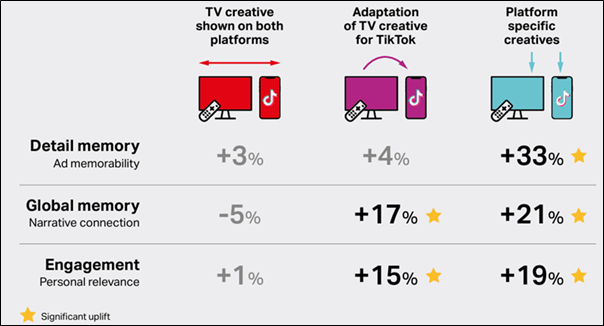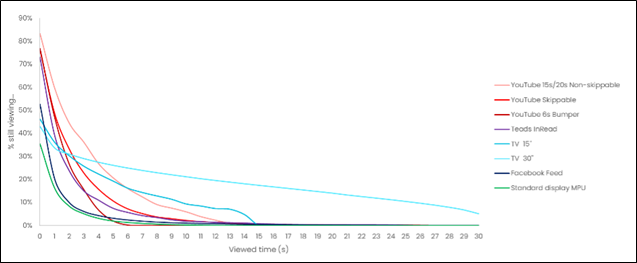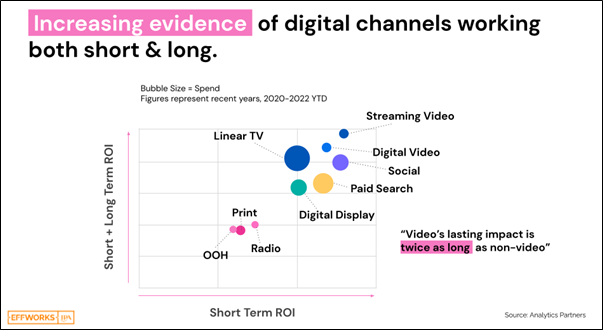By Mohini Lakhani, Digital Business Director
At Cannes Lions International Festival of Creativity 2023, Les Binet, Tom Roach and Dr Grace Kite first debuted, what they coined, The Third Age of Effectiveness. In this session, they discussed that whilst Digital, has long been viewed as a channel for Direct Response (DR) and short-term sales, due to its ability to prove effectiveness through sound attribution methodology, robust econometric analysis is now evidencing how it also has a vital role in long-term brand-building.
They asserted that the repositioning of traditional Digital media, once primarily web and mobile focused, has significantly enhanced its perception beyond that of a pure effectiveness driver, through its expansion into OOH, audio, and TV. Whilst any single channel in isolation isn’t enough to shift the dial on brand metrics alone, we shouldn’t dismiss the contribution of Digital.
Online video has played a pivotal role in this evolution, with traditional channels innovating their product offerings to a focus on this – e.g. Meta’s reels, YouTube’s shorts, and even Google’s introduction of Performance Max and Demand Gen. Smart TVs have undoubtably shaken up how traditional TV is consumed, exhibited by the growth of BVOD, SVOD, and AVOD in recent years. The sheer diversification of video has reiterated the importance of having bespoke creative that feels native to each individual platform, rather than just repurposed TV assets, which, together, fundamentally builds the foundations of strong brand equity. For example, this is backed by research by TikTok and Neuro-Insight.

So, two years down the road, how far have we progressed in this new era? Ultimately, there are four key forces driving this repositioning:
The Attention Economy
It’s well known that TikTok influenced the surge of short-form content being consumed, with other advertisers quickly following suit to reach their audiences in high-attention and immersive environments. Many platforms are still playing catch up, though this is just inevitably leading to a saturated market, leaving advertisers fighting tooth and nail for their audience’s attention.
Research from TikTok and System1, demonstrates that eliciting emotion through creative is the key to supporting brand building, with ads that evoke happiness and surprise both proving best effective, though brands crucially only have an average of two seconds to generate the hook.
Sequencing (or sequential messaging) can be another effective way to strengthen brand saliency, as it relies on priming principles, leaving audiences wanting more. This is particularly effective through YouTube, scoring as second highest on the scale on Lumen’s attention curve by media channel.

The Role of Generative AI in Creativity
AI is having an irrefutable impact on creativity. To meet the attention requirements of audiences mentioned in the previous section, this can naturally be a time-consuming and resource heavy process. However, with tech evolving at lightning speed, Generative AI tools are supporting the versioning of bespoke creative to meet individual platform needs in record time, supporting the need for having enough variants within the testing pipeline to hold users’ attention in saturated markets.
I won’t dwell too much on this topic too much further as our Chief Digital Officer, Ben Foster, already wrote about this in an article published in March 2025.
A Changing Privacy Landscape
In recent years, we’ve seen developing privacy legislations keeping the big ad tech players on their toes, and subsequently, advertisers on the back foot. For example, Meta’s announcement from earlier this year saw Healthcare brands operating in Europe, having to change tactic from optimising to website events, thus being able to identify warm audiences to create lookalikes off of or retargeting, to now relying on upper funnel metrics or at best, in-platform lead generation. With grey areas in Meta’s detection policies, this has impacted businesses operating in far beyond the traditional healthcare industry, e.g. charities whose proposition may centre around healthcare conditions. Beyond this, TikTok’s ban in the US is still looming, with brands already having diversified advertising spend as a result. A continually changing landscape has forced many advertisers widening the lens on their classification of what success looks like for Digital.
Reframing Measurement Beyond the Short-Term
At The Kite Factory, we have led on client roadshows focused on measurement and reporting in what could soon be a “cookieless” era, largely centred around the gold standard of econometric modelling, which can ultimately ascertain the true effectiveness of channels, all the while producing diminishing returns curves to determine headroom. Whilst off-the-shelf channel-centric models such as Meta’s Robyn and Google’s Meridian have started to pave the way for increased consideration and uptake of Marketing Mix Modelling (MMMs), we believe that independent third-party econometric analysis should be undertaken as to avoid platform bias and data siloes.
Between bursts of MMMs, taking a location-based approach to media planning and measurement is something we are leading on at The Kite Factory, with intent to understand incremental impacts of channels against high-indexing audiences. This for us is playing a crucial role in proving effectiveness without reliance on last-click attribution methodology that has been used to measure the success of Digital for so long.
Both routes are demonstrating a strong correlation of the impact of Digital with successful short and long-term outputs on their direct business outcomes, leading to more reinvestment towards online video in particular, with advertisers now embracing this increasingly as a part of the media mix.

The long and short of it is that Digital is far from a one-stop shop. Whilst efficiencies might be becoming more compounded due to reduced reliability on traditional linear attribution methodology, narratives must be shifted away from a reduced view on short-termism and start considering the value of these channels for long-term brand building, supporting the broader media funnel in the process.
If you would like to hear more about how we can support, please get in touch.
